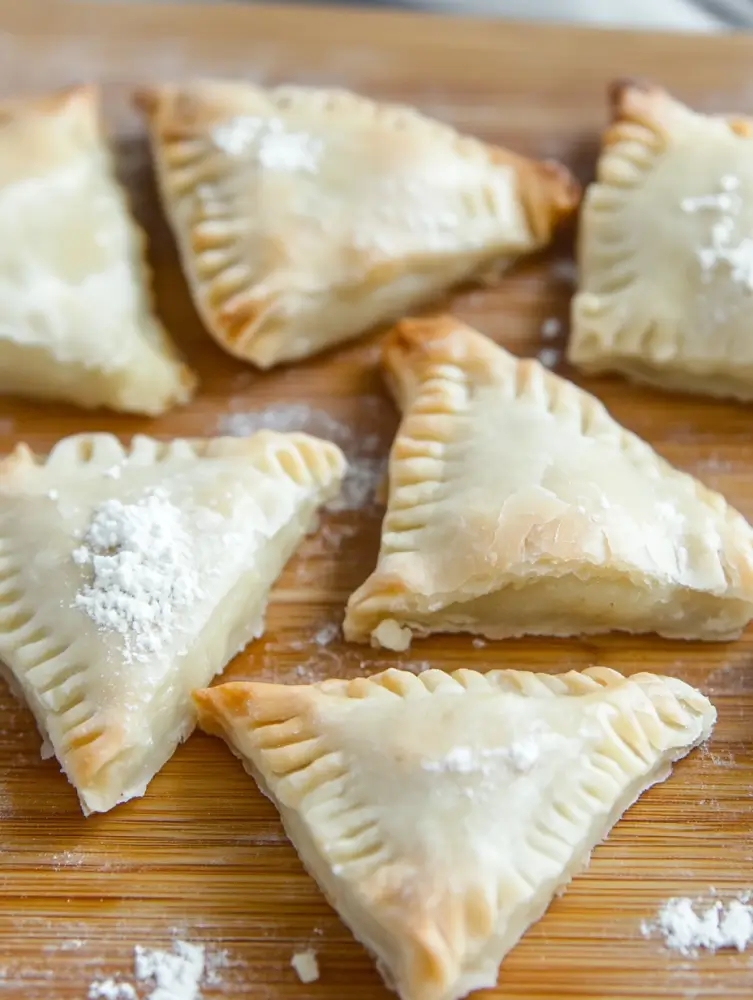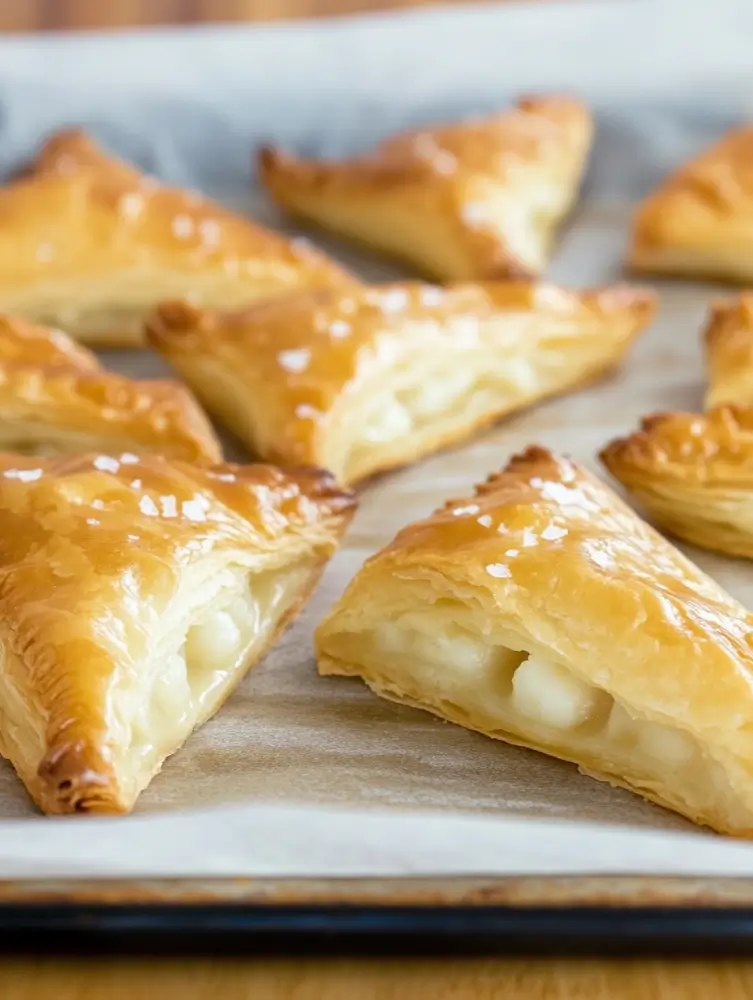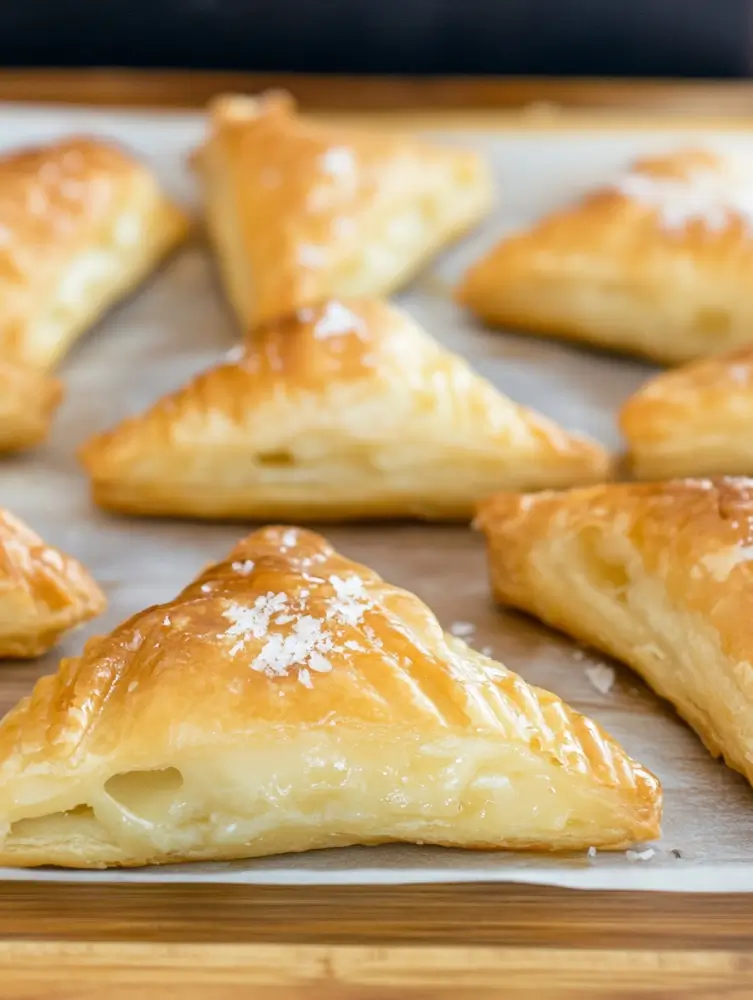In this article, you’ll discover how to make potato-filled pastries from scratch, learn secrets to getting that golden, flaky crust, and explore regional variations like potato bourekas and potato puffs. You’ll even pick up serving tips, filling twists, and answers to the most Googled questions about pastry making.
Check out this cheesy twist on filled pastries in our Cheese Dreams Recipe for more flaky goodness.
In This Post
Introduction to Potato Filled Pastries
What Is a Potato Filled Pastry?
A potato filled pastry is a savory baked or fried treat made by wrapping a spiced mashed or diced potato filling in pastry dough. These pastries come in various shapes—triangles, rolls, crescents—and can be baked, fried, or air-fried to golden perfection. They’re often enjoyed as snacks, appetizers, or part of a hearty breakfast.
From the buttery French-style puff pastry to flaky phyllo layers, the dough choice can define your flavor experience. The filling is just as flexible—potatoes alone or paired with cheese, onions, herbs, or spices to suit your taste.
History and Origin of Potato-Based Pastries Around the World
Potato pastries are beloved across continents. In the Middle East, potato bourekas are a popular bakery staple. In India, aloo samosas fill a spiced mashed potato mixture inside crispy dough. In Latin America, you’ll find empanadas with creamy potato and beef fillings. And in Europe, variations like pierogi and Cornish pasties show just how far and wide these hearty pockets have traveled.
Each culture brings its own twist to the table, but one thing remains constant: the unbeatable combo of flaky pastry and tender, flavorful potato filling.

Core Ingredients and Tools You’ll Need
Choosing the Right Potatoes for Filling
The foundation of any great potato filled pastry recipe starts with—you guessed it—the potatoes. Not all potatoes behave the same when cooked, so selecting the right type makes a big difference in texture and flavor.
Here’s a quick breakdown of your best choices:
| Potato Type | Texture | Best For |
|---|---|---|
| Russet | Fluffy, starchy | Classic mashed potato filling |
| Yukon Gold | Creamy, slightly waxy | Rich and smooth filling with body |
| Red Potatoes | Waxy | Chunky fillings or diced potato styles |
| Sweet Potatoes | Soft, sweet | Unique sweet-savory twist on the classic |
Pro Tip: Russets absorb flavors like butter, garlic, and spices well, making them ideal for flavorful fillings. If you’re aiming for a firmer texture, go with Yukon Gold or red potatoes.
Don’t forget to season your filling! Common add-ins include sautéed onions, chopped parsley, black pepper, cumin, turmeric, and shredded cheese.
Must-Have Tools and Ingredients for Perfect Pastry Dough
Making homemade pastry dough may sound intimidating, but with the right tools and pantry items, it becomes second nature.
Essential Tools:
- Mixing bowls: For combining your dough and filling.
- Rolling pin: To roll out dough evenly.
- Pastry cutter or knife: For clean cuts and shaping.
- Pastry brush: Ideal for egg wash application.
- Baking sheet with parchment paper: Prevents sticking and ensures even baking.
Dough Ingredients Checklist:
- All-purpose flour: The base of your pastry.
- Cold butter or shortening: Creates flakiness in layers.
- Ice water: Keeps dough from getting too warm.
- Salt: Enhances flavor.
- Optional: Egg yolk for richness or vinegar for tenderness.
If you’re short on time, you can use store-bought puff pastry or phyllo sheets. But for a traditional, flaky bite, homemade dough is worth the effort.
Discover great ideas like this Irresistible Raspberry Flapjacks if you’re craving something sweet after your savory pastry project.
How to Make Potato Filled Pastry Step-by-Step
Preparing the Potato Filling (Spices, Textures & Tips)
The filling is the star of your potato filled pastry, so let’s make it rich, flavorful, and perfectly textured. Start by boiling or steaming your potatoes until they’re fork-tender. Once they’re soft, drain and mash (or dice, depending on your preferred texture).

Here’s a go-to filling recipe:
Basic Savory Potato Filling:
- 3 large Russet or Yukon Gold potatoes (peeled & boiled)
- 1 small onion, finely chopped and sautéed
- 2 tablespoons olive oil or butter
- 1 teaspoon cumin or curry powder (optional for extra flavor)
- Salt and pepper to taste
- Fresh parsley or cilantro, chopped
- Optional: shredded cheese or crumbled feta for richness
Steps:
- Heat oil in a pan and sauté onions until golden.
- Add mashed potatoes, spices, herbs, and seasonings.
- Stir until well combined. Let it cool before filling pastries.
Tips for Texture:
- Want a chunkier bite? Dice the potatoes instead of mashing.
- Like it creamy? Mix in a bit of cream cheese or melted butter.
- Going spicy? Add minced jalapeños or red pepper flakes.
Looking for inspiration? Try these Oatmeal with Bananas and Almonds as a breakfast idea that’s just as filling—but on the sweeter side.
Making the Perfect Pastry Dough from Scratch
While store-bought dough is convenient, homemade pastry dough gives unmatched flavor and texture. Here’s a basic recipe for flaky pastry:
Basic Pastry Dough:
- 2 ½ cups all-purpose flour
- 1 cup cold unsalted butter (cubed)
- ½ teaspoon salt
- 6–8 tablespoons ice water
Directions:
- In a bowl, mix flour and salt. Add cold butter cubes.
- Using a pastry cutter or your fingers, blend until the mix resembles coarse crumbs.
- Add ice water gradually, mixing until a dough forms.
- Shape into a ball, cover in plastic wrap, and chill for 30–45 minutes.
Rolling and Cutting:
- Lightly flour your surface and rolling pin.
- Roll out dough to about 1/8-inch thickness.
- Cut into squares or circles depending on your pastry shape preference.
Shortcut Tip: Using puff pastry? Let it thaw fully and handle gently to keep those flaky layers intact.
Assembly and Baking Process
Assembling the Pastries: Folding, Sealing & Styling Techniques
Once your filling is cool and your dough is ready, it’s time to put everything together.
Here’s how to assemble your potato filled pastries like a pro:
1. Roll and Cut the Dough
- Roll out the chilled dough on a lightly floured surface to about 1/8-inch thickness.
- Cut into your desired shape: squares for pockets, circles for hand pies, or triangles for turnovers.
2. Add the Filling
- Spoon 1 to 2 tablespoons of your cooled potato filling into the center of each piece.
- Don’t overfill! Too much filling will cause the pastries to burst during baking.
3. Fold and Seal
- Fold over your pastry: square into a rectangle, circle into a half-moon, triangle into a mini-samosa.
- Use a fork to crimp the edges firmly and seal them shut.
- Optional: Brush a bit of water or egg wash around the edges for better sealing.
4. Add Style
- For golden, shiny tops, brush with egg wash (1 egg + 1 tbsp milk or water).
- Sprinkle sesame seeds, nigella seeds, or sea salt for an extra touch.
Oven vs. Air Fryer: Baking Methods Compared
Depending on what tools you’ve got at home, you can go the traditional oven route or get crispy results faster with an air fryer. Here’s how they stack up:
| Method | Temp & Time | Results | Best For |
|---|---|---|---|
| Oven | 375°F (190°C) for 20–25 mins | Golden, evenly baked | Large batches |
| Air Fryer | 350°F (175°C) for 10–12 mins | Crispier edges, faster cooking | Small batches, quick snacks |
Tips:
- Always preheat your oven or air fryer.
- Line baking trays with parchment paper.
- Leave space between pastries so they puff evenly and don’t stick.
Check out this twist on traditional filled pastries in our Blooming Quesadilla Ring — perfect for gatherings and party-style serving.

Potato Bourekas and Global Variations
What Is a Potato Boureka and Why You’ll Love It
Potato bourekas are a Middle Eastern delight—flaky, golden, and packed with a creamy potato filling that’s often mixed with cheese or herbs. These pastries are typically made using puff pastry or phyllo dough and folded into triangles or rectangles.
They’re a popular street food and snack in countries like Israel, Turkey, and parts of the Balkans. What makes them stand out is their light texture, generous filling, and savory toppings like sesame or nigella seeds.
Typical Potato Boureka Filling:
- Mashed potatoes
- Feta or kashkaval cheese
- Fried onions
- Salt, pepper, and nutmeg
- Optional: fresh dill or parsley
Serving Idea: Warm potato bourekas pair beautifully with boiled eggs, sliced tomato, pickles, and a side of tahini or yogurt sauce.
Why you’ll love them:
- Quick to assemble with store-bought puff pastry
- Freezer-friendly and easy to batch-cook
- A crowd-pleaser at parties or brunch
Other Regional Variants: From Indian Samosas to Latin Empanadas
Potato-filled pastries have taken on different forms around the world, and every culture brings its own twist to this comforting classic.
1. Indian Samosas
Crispy, deep-fried triangles filled with spiced mashed potatoes, peas, and herbs. They’re served with tamarind or mint chutney and are a must-have at Indian gatherings.
Key Ingredients:
- Boiled potatoes
- Cumin, coriander, turmeric
- Green peas and chilies
- Cilantro and lemon juice
2. Latin American Empanadas
In countries like Argentina, Chile, and Colombia, empanadas often include diced or mashed potatoes along with meat, cheese, or eggs. They’re baked or fried depending on the region.
Signature Flavors:
- Potato and ground beef
- Potato and cheese
- Potato with ají or chimichurri sauce
3. Polish Pierogi
These dumpling-style pastries are filled with a mix of potatoes and cheese, boiled, and often pan-fried in butter until golden brown.
4. Caribbean Patties
Jamaican-style patties sometimes feature curried potato as a vegetarian filling, wrapped in a flaky turmeric-infused crust.
No matter where you go, people love combining potatoes and pastry—a timeless combo of crisp and creamy, hearty and satisfying.
Tips and Tricks for Golden, Flaky Pastry
The Golden Rule of Pastry Making Explained
If there’s one pastry rule you never want to break, it’s this:
“Keep everything cold, and don’t overwork the dough.”
This simple mantra is the backbone of any great potato filled pastry recipe. Here’s why it works:
- Cold Butter = Flaky Layers
Cold chunks of butter melt during baking, creating steam that puffs up the layers for that signature flake. - Overworking = Tough Texture
Kneading too much develops gluten, which makes pastry chewy—not what you want. Mix just until the dough holds together.
Other Golden Pastry Rules:
- Use ice water, not tap water, when mixing the dough.
- Rest the dough in the fridge before rolling—it relaxes the gluten.
- Roll from the center outwards with light pressure.
- Avoid warm hands: use a pastry cutter or fork to blend butter into flour.

Avoiding Common Pastry Fails (Soggy Bottoms, Leaky Fillings)
Even experienced bakers can fall victim to the classic pastry mishaps. Here’s how to dodge them:
1. Soggy Bottom Syndrome
Nothing ruins a potato pastry faster than a doughy, uncooked base.
Fix it with:
- Baking on a preheated tray or stone.
- Using a light layer of semolina flour or breadcrumbs under the filling to absorb moisture.
- Avoiding over-wet fillings.
2. Leaky Edges
If the filling spills out, it can burn or dry out.
Fix it with:
- Not overstuffing.
- Crimping edges tightly with a fork.
- Brushing a bit of water or egg on the dough before sealing.
3. Dough Shrinkage
Dough that shrinks while baking usually wasn’t rested properly.
Fix it with:
- Chilling dough after shaping, before baking.
- Not stretching dough too thin.
Don’t miss our Banana Cheesecake for another golden-baked treat that nails the texture and flavor balance.
Creative Twists to Try at Home
Adding Cheese, Herbs, or Meats to the Potato Filling
Potato filling is a blank canvas. With just a few added ingredients, you can transform it from traditional to gourmet.
Cheesy Additions:
- Feta or Goat Cheese: Adds tang and creaminess, perfect for Mediterranean-style pastries.
- Shredded Cheddar or Mozzarella: Melts beautifully for a gooey bite.
- Parmesan: Gives a salty kick and crispy edge when baked.
Savory Add-Ins:
- Caramelized onions or leeks for sweet depth.
- Sauteed spinach or kale for extra nutrition.
- Cooked bacon, ground beef, or chicken for heartier fillings.
Fresh Herbs That Pair Well with Potatoes:
- Parsley
- Dill
- Thyme
- Chives
- Cilantro
These additions don’t just boost flavor—they turn your potato filled pastry into a meal rather than just a snack.
Making Vegan and Gluten-Free Variants of Potato Pastries
Don’t worry, plant-based and gluten-sensitive foodies—we’ve got you covered!
Vegan Potato Pastry Version:
- Use olive oil or vegan butter in the dough.
- Skip the egg wash—substitute with plant milk or aquafaba (chickpea water).
- Add nutritional yeast or vegan cheese for that umami cheesy hit.
Gluten-Free Potato Pastry Dough Tips:
- Use a gluten-free flour blend (preferably with xanthan gum).
- Add an extra tablespoon of water to keep the dough flexible.
- Chill the dough longer and handle it gently.
You’d be surprised how beautifully these alternatives turn out—crispy on the outside, creamy on the inside.
Don’t miss our Apple Spice Cake if you’re looking for a sweet treat to balance the savory magic of your pastries.
Serving Ideas and Storage Tips
Best Dips and Sides for Potato Filled Pastry
Potato pastries are delicious on their own—but paired with the right sides or dips, they transform into something next-level. Whether you’re hosting guests or packing lunchboxes, these combos will win hearts.
Savory Dip Ideas:
- Garlic Aioli – Creamy and garlicky, perfect for crispy pastries
- Yogurt Dill Sauce – Tangy and fresh, balances the richness of the filling
- Spicy Tomato Chutney – Brings heat and depth, great with Indian-style pastries
- Sour Cream with Chives – Classic combo that never fails
Side Dish Pairings:
- Simple Salad – Fresh greens with lemon vinaigrette cut through the pastry’s richness
- Soup – Serve with tomato soup, lentil soup, or butternut squash soup for a cozy meal
- Pickles or Olives – Great for Middle Eastern–style potato bourekas
Looking to serve it for breakfast or brunch? Pair it with boiled eggs, sliced cucumbers, and fresh bread for a Mediterranean-style spread.
Storing and Reheating: How to Keep Them Fresh
Baked a big batch? No problem. Potato filled pastries store and reheat beautifully if done right.
Storage Tips:
- Room Temp: Keep in an airtight container up to 1 day.
- Refrigerator: Store in a sealed container for up to 4 days.
- Freezer: Wrap each pastry in foil or parchment, then place in a freezer-safe bag. Good for up to 3 months.
Reheating Tips:
| Method | Temp & Time | Results |
|---|---|---|
| Oven | 350°F for 10–12 minutes | Crispy and evenly heated |
| Air Fryer | 330°F for 6–8 minutes | Extra crispy edges |
| Microwave | 60–90 seconds (not recommended) | Soft, but loses crispiness |
Pro Tip: If frozen, reheat straight from the freezer—no thawing needed. Just extend baking time by a few minutes.

Potato Filled Pastry Recipe
- Total Time: 50 minutes
- Yield: 12 pastries 1x
- Diet: Vegetarian
Description
A golden, flaky potato filled pastry recipe packed with creamy spiced potatoes and wrapped in buttery dough. Perfect for snacking, brunch, or a comforting appetizer—customize it with cheese, herbs, or even meat!
Ingredients
- 3 large Russet or Yukon Gold potatoes, peeled and boiled
- 1 small onion, finely chopped
- 2 tbsp olive oil or butter
- 1 tsp cumin
- Salt and pepper to taste
- 2 tbsp chopped parsley or dill
- 1 egg (for egg wash)
- 1 pack puff pastry (or homemade pastry dough)
- Optional: ½ cup shredded cheddar or feta cheese
Instructions
- Boil potatoes until fork-tender. Mash in a large bowl.
- Sauté chopped onions in oil until golden. Add to mashed potatoes.
- Season filling with cumin, salt, pepper, and herbs. Mix well.
- Roll out pastry dough to ⅛-inch thickness. Cut into squares or circles.
- Spoon filling onto center of each piece. Fold, seal with a fork.
- Brush tops with egg wash. Sprinkle sesame seeds if desired.
Bake at 375°F (190°C) for 20–25 minutes or until golden brown.
Notes
- To make it vegan, use dairy-free butter and skip egg wash (use plant milk).
- Freeze unbaked pastries on a tray, then transfer to bags for up to 3 months.
- Serve with yogurt sauce, spicy chutney, or garlic aioli for a flavor boost.
- Prep Time: 25 minutes
- Cook Time: 25 minutes
- Category: Snack, Appetizer
- Method: Baking
- Cuisine: Middle Eastern / European Fusion
Nutrition
- Serving Size: 1 pastry
- Calories: 210 kcal
- Sugar: 1g
- Sodium: 280mg
- Fat: 11g
- Saturated Fat: 5g
- Unsaturated Fat: 5g
- Trans Fat: 0g
- Carbohydrates: 25g
- Fiber: 2g
- Protein: 4g
- Cholesterol: 20mg
Keywords: potato filled pastry recipe, puff pastry, savory pastry, comfort food
FAQs About Potato Filled Pastry Recipe
How to make a potato pastry?
To make a classic potato pastry, start by preparing a flavorful mashed potato filling—usually with sautéed onions, spices, and sometimes cheese. Next, make or use pre-made pastry dough, roll it out, and cut it into squares or circles. Spoon the filling into the center, fold the dough, seal the edges, and bake until golden brown. You can also brush the tops with egg wash for extra shine and crisp.
What are the 4 types of pastry?
The four main types of pastry are:
1 Shortcrust Pastry – Ideal for tarts and pies; buttery and crumbly.
2 Puff Pastry – Layered and flaky; perfect for potato-filled snacks.
3 Choux Pastry – Light and airy, used in eclairs and cream puffs.
4 Filo (Phyllo) Pastry – Thin, crisp layers; often used in Middle Eastern pastries like bourekas.
For a potato filled pastry recipe, puff and filo are your best bet for a crispy, flaky texture.
What is a potato boureka?
A potato boureka is a flaky pastry popular in Israeli and Turkish cuisine. It’s usually made with puff pastry or phyllo dough, filled with mashed potatoes (often mixed with cheese and herbs), and folded into triangle or rectangle shapes. They’re brushed with egg wash, topped with sesame seeds, and baked to golden perfection. Think of it as the Middle Eastern cousin of a potato puff!
What are potato puffs made of?
Potato puffs are bite-sized, crispy snacks made from mashed potatoes, flour (or breadcrumbs), cheese, and seasonings. Some recipes use choux pastry to make them airy and light, while others use mashed potatoes rolled in coating and deep-fried. They’re great finger foods for parties and a fun twist on the classic pastry.
What is the golden rule of pastry making?
The golden rule of pastry making is:
“Keep your ingredients cold and don’t overwork the dough.”
This ensures that your butter stays in solid chunks, which melts during baking to create those delicious, flaky layers. Overworking the dough causes gluten to form, making your pastry chewy instead of tender.
Do you put egg in potato bake?
Yes, some potato bake recipes include eggs to help bind the layers and add creaminess. However, it’s not necessary for all versions. In pastries, eggs are usually used in the egg wash on top to create that golden, shiny crust.
Conclusion
Mastering the potato filled pastry recipe is easier than you think—and the results are always crowd-pleasing. With flaky layers and a rich, savory filling, this dish brings together comfort, creativity, and culinary tradition from around the world.
From classic bourekas to custom cheesy puffs, you now have the know-how to bake with confidence. Whether you’re hosting brunch, prepping school snacks, or just indulging in a warm pastry with tea—this guide has your back.
Looking for more crave-worthy bakes? Don’t miss our Banana Cheesecake and Apple Spice Cake — the perfect sweet companions to your savory success!
Stay updated with more quick and easy recipes! Follow us on Facebook and Instagram for daily inspiration, new recipes, and baking tips!


